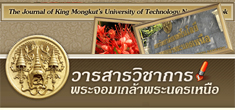บทคัดย่อ
A small-scale of turned windrow system was applied to recycle the residue waste from curcuma nursery as compost material. The mixture was piled with cow manure, pig manure, residue waste, and used sawdust at the ratio of 1:0.1:0.9:0.6 (wet weight basis), and adjusted to the initial C/N ratio of 30 and moisture content between 50-60%. The performance of two replicates of composting piles (width 1.5m, length 2 m and height 1.5m) was investigated by measuring physical and chemical parameters including temperature, moisture content, pH, C, and C/N. The effect of composting ages to plant toxicity including seed germination, root length, and germination index of three plant species (Canton lettuce, Chinese spinach, and Cucumber) was examined. The result indicated that both piles achieved thermophile phase (50-60oC) within 3 days and remained at this level for 20 days, thus satisfying the PFRPs (Process to Further Reduce Pathogens). The rate constant (k rate) for organic C decomposition which follows first-order kinetic model and the dry mass loss of both piles were about 0.013 day-1and 24-33%, respectively. The phytotoxicity test indicated that the inhibitory effects of compost on seed germination, root length, and germination index (GI) of three plant species were observed in the first 20 days of composting and decreased with the age of compost onwards. The qualities of final compost of replicates were acceptable and similar to the recommended criteria regulated by Department of Agriculture of Thailand (2548 B.E.). It is also recommended that two months is suitable composting period for this investigation and turning every 15 days should be adopted for an effective process.
A small-scale of turned windrow system was applied to recycle the residue waste from curcuma nursery as compost material. The mixture was piled with cow manure, pig manure, residue waste, and used sawdust at the ratio of 1:0.1:0.9:0.6 (wet weight basis), and adjusted to the initial C/N ratio of 30 and moisture content between 50-60%. The performance of two replicates of composting piles (width 1.5m, length 2 m and height 1.5m) was investigated by measuring physical and chemical parameters including temperature, moisture content, pH, C, and C/N. The effect of composting ages to plant toxicity including seed germination, root length, and germination index of three plant species (Canton lettuce, Chinese spinach, and Cucumber) was examined. The result indicated that both piles achieved thermophile phase (50-60oC) within 3 days and remained at this level for 20 days, thus satisfying the PFRPs (Process to Further Reduce Pathogens). The rate constant (k rate) for organic C decomposition which follows first-order kinetic model and the dry mass loss of both piles were about 0.013 day-1and 24-33%, respectively. The phytotoxicity test indicated that the inhibitory effects of compost on seed germination, root length, and germination index (GI) of three plant species were observed in the first 20 days of composting and decreased with the age of compost onwards. The qualities of final compost of replicates were acceptable and similar to the recommended criteria regulated by Department of Agriculture of Thailand (2548 B.E.). It is also recommended that two months is suitable composting period for this investigation and turning every 15 days should be adopted for an effective process.
Keywords : Composting turned windrow, Curcuma, Nursery




